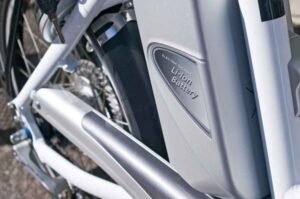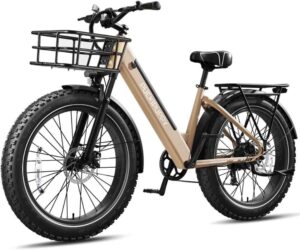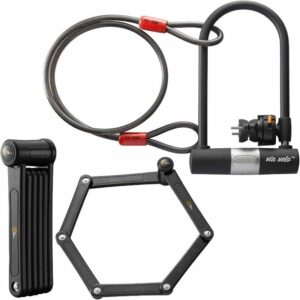Are Electric Bikes Easier to Balance?
A Closer Look
Key Takeaways
-
-
Electric bikes, given their additional components like the motor and battery, carry more weight than traditional bikes, potentially contributing to enhanced stability and balance, especially at higher speeds.
-

Factors such as the type and location of the motor, the level of assistance, frame design, and even tire size and type, play crucial roles in influencing an e-bike’s balance.
-
Beginners should embrace the learning process, starting with lower assistance levels and gradually increasing as they gain confidence and mastery over the e-bike.
-
Adapting to different terrains and understanding the impact of speed on balance are essential skills to develop for an optimized e-bike riding experience.
-
The transition from traditional bikes to e-bikes requires some adaptation, but with practice and understanding of the e-bike’s unique dynamics, this transition can be smooth.
-
Selecting an e-bike that aligns with your comfort level and balancing capabilities can significantly enhance the riding experience and balance. Consider elements like frame design, weight, and motor type when choosing your e-bike.
-
Balancing Act: E-Bikes and the Quest for Stability
Considering the transition to e-bikes from traditional bicycles can raise several queries, particularly concerning the aspect of balance: Do electric bikes actually offer a simpler or more stable balancing experience? In this comprehensive article, we’ll dissect the intricate attributes that set e-bikes apart and shape their balance dynamics. Through this, you’ll gain a thorough understanding of e-bike functionality and handling, enabling you to make an informed decision as you prepare to embrace the exhilarating world of electric biking.
By diving deep into the characteristics that affect an e-bike’s balance, such as weight distribution, motor placement, assistance levels, and even tire types, we aim to provide you a clear picture of the e-bike riding experience. Whether you’re a seasoned cyclist or a newcomer to the two-wheel scene, this guide will aid you in understanding how e-bikes can offer stability, especially for those willing to familiarize themselves with their unique riding mechanics.
As you read on, we’ll explore these factors in detail and delve into practical advice to further enhance your e-bike riding skills and balance proficiency.
Key Aspects Influencing Balance on an Electric Bike
-
Weight Distribution: Electric bikes typically weigh more than their traditional counterparts, mainly due to the incorporation of the motor and battery system. However, this added weight is not necessarily a disadvantage. In fact, it can improve stability and balance, particularly when traveling at higher speeds.

-
Motor Placement: The motor’s position on the bike can significantly impact its balance. E-bikes featuring mid-drive motors have a more centralized weight distribution, which typically enhances the sense of balance and stability. Nevertheless, e-bikes equipped with hub motors, especially those located in the rear wheel, can also deliver a well-balanced riding experience.
-
Power Assistance Levels: The level of pedal assist can affect the perceived ease of balancing an e-bike. At lower assistance levels, the e-bike’s handling can closely mimic that of a regular bicycle, while higher levels amplify the power output, which might require an adjustment period for the rider.
-
Frame Structure: The design of an e-bike’s frame can also play a pivotal role in its balance. Certain e-bikes feature a step-through frame design that effectively lowers the center of gravity, resulting in enhanced stability and a more balanced ride.
Choosing the Right E-Bike for Better Balance
Selecting the right e-bike can greatly influence your riding experience, balance, and overall comfort. Here are several key factors to consider when choosing an e-bike:
-
Frame Design: The design of the e-bike frame plays a significant role in the bike’s balance and stability. A step-through frame, for instance, lowers the bike’s center of gravity, enhancing stability and making it easier to mount and dismount. If you are concerned about balance, consider opting for a bike with a step-through design.
-
Weight: The weight of an e-bike is a crucial factor that influences balance. Heavier bikes tend to be more stable at higher speeds, but they might be harder to handle at slower speeds or when stationary. Consider your physical capabilities and where you plan to ride before deciding on a heavier or lighter model.
-
Motor Type: The location of the motor can affect a bike’s balance. Mid-drive motors, positioned near the pedals, centralize the weight and help improve balance. On the other hand, hub motors can still provide a balanced ride, particularly when the motor is located in the rear wheel.
-
Battery Position: The positioning of the battery can influence the overall balance of the e-bike. Batteries mounted centrally and low on the frame contribute to better weight distribution and balance.

-
Tire Type and Size: Larger and wider tires can increase an e-bike’s stability and ease of balance. Fat tire e-bikes are known for their excellent balance and ability to handle a variety of terrains.
-
Test Ride: Perhaps the most important factor in choosing an e-bike is how comfortable you feel riding it. If possible, take a test ride to assess the bike’s balance and how well it suits your riding style.
By carefully considering these factors and opting for a test ride, you can find an e-bike that best fits your balance abilities and comfort level, ensuring a more enjoyable and confident riding experience.
Transitioning from Traditional Bikes to E-Bikes
Switching from a traditional bike to an e-bike can be an exciting yet somewhat daunting prospect. With a few key considerations in mind, you can ensure a smoother transition and quickly adapt to the changes in balance:
-
Weight Differences: E-bikes are generally heavier due to the additional components like the motor and battery. This added weight can improve stability, especially at higher speeds, but may also require a bit of adjustment in terms of handling, particularly when lifting or moving the bike.
-
Motor Assistance: E-bikes offer varying levels of motor assistance that can significantly enhance your speed with less pedaling effort. Start with lower levels of assistance to get used to the additional power, gradually increasing as you gain confidence.
-
Braking: The increased weight and potential speed of an e-bike can affect your braking distance. You’ll need to anticipate stops and start braking earlier than you might on a traditional bike. E-bikes often
 come with high-quality brakes to compensate for these factors.
come with high-quality brakes to compensate for these factors. -
Speed Adaptation: E-bikes can reach higher speeds more effortlessly compared to traditional bikes. Practice at different speeds to get accustomed to the feeling of faster travel and understand how it impacts your balance.
-
Battery Management: Remember to monitor your battery levels during rides. Running out of battery mid-ride will turn your e-bike into a regular (but heavier) bike, requiring more effort to pedal, particularly uphill.
-
Practice: The key to transitioning smoothly from a traditional bike to an e-bike is practice. Spend time getting to know your new e-bike: test the different pedal-assist levels, adjust your speed, and practice maneuvering and braking in a safe, controlled environment before venturing onto busier roads.
Remember, the aim is not just to ride, but to ride safely and confidently. With time and practice, you’ll master the nuances of e-bike balance and enjoy the new possibilities that electric biking brings.
E-Bike Tires and Balance
The type and size of tires on your e-bike play a significant role in your overall balance and stability. Tires act as the primary contact point between the bike and the ground, therefore their characteristics can dramatically impact how your e-bike responds to various riding conditions.
-
Tire Type: E-bike tires generally come in two main types: clincher (or wire bead) and folding. Clincher tires, being more rigid, can provide a sense of stability and are often used by beginners. Folding tires, on the other hand, are typically lighter and more flexible, preferred by more experienced riders for their performance characteristics.
-
Tire Size: The size of your tires, including their width and diameter, can greatly affect your balance. Larger and wider tires generally provide more stability and are more forgiving on rough or loose surfaces, making them ideal for off-road e-bikes. Smaller and narrower tires, while offering less surface contact, can offer quick responsiveness, making them suitable for city riding or on smooth, paved surfaces.

-
Tire Pressure: The pressure in your tires also influences balance and stability. Over-inflated tires may result in a harsh ride and decreased traction, while under-inflated tires can feel sluggish and increase the risk of a flat tire. Finding the right tire pressure for your weight and riding conditions can improve balance, comfort, and the overall riding experience.
-
Tread Pattern: The tread pattern on your e-bike tires can influence their grip and your balance, especially on different terrains. For instance, tires with larger knobs are ideal for off-road and muddy conditions as they provide better grip and stability. On the other hand, smoother tires are perfect for city or road riding as they offer lower rolling resistance and are quieter.
Understanding your riding conditions and choosing the appropriate tire type, size, pressure, and tread can significantly enhance the stability and balance of your e-bike, contributing to a safer and more enjoyable riding experience.
Mastering Balance on Your Electric Bike
Despite the inherent advantages electric bikes offer in terms of balance and stability, it’s crucial to dedicate time to practice before embarking on longer journeys. For novices, it’s beneficial to initiate their e-bike experience on a lower assistance level. This setting emulates the experience of riding a traditional bike, providing an excellent opportunity to adjust to the weight and feel of the e-bike.
As you continue to practice, you’ll build a sense of familiarity with the bike’s dynamics, including the impact of the motor’s power on the ride. When you’re comfortable at a lower level, gradually increase the assistance level. This incremental approach allows you to adapt to the enhanced power output in a controlled manner, gradually enhancing your skill and confidence on the e-bike.
Remember, it’s not just about learning to balance the e-bike, but also about understanding how to handle the bike at different speeds and in varying conditions. Practicing starts, stops, turns, and maneuvering through obstacles will significantly improve your overall riding proficiency.
In addition, take time to understand your e-bike’s features. Familiarize yourself with the controller, learn how the different levels of pedal assistance affect your ride, and how to handle the bike when the motor is assisting your pedaling. Ultimately, the key to mastering balance on your e-bike is consistent practice and a thorough understanding of the bike’s unique features.

Adapting to Different Terrains
Maintaining balance on your e-bike across various terrains requires an understanding of the terrain’s unique demands and adjusting your riding techniques accordingly. Here’s some advice to help you navigate different terrains:
-
Hills: Uphill riding can challenge your balance due to the gravitational pull against your direction of motion. E-bikes excel in this situation, as the motor can provide additional power. Lean forward slightly to distribute your weight and keep the bike stable. For downhill rides, shift your weight backward, and use your brakes wisely to maintain control without skidding.
-
Off-Road Trails: Off-road terrains like dirt trails or gravel paths often have unpredictable surfaces, which demand careful handling. For increased stability, use wider tires with more aggressive treads. Remember to adjust your tire pressure for better traction. Keep your body loose and slightly bend your knees and elbows to absorb shocks and bumps.
-
Urban Environments: Urban riding involves navigating traffic, pedestrians, and varied road conditions. Maintain an upright position for better visibility. Be vigilant about your surroundings, anticipate turns, and always signal your intentions to other road users. Smooth, narrow tires with moderate pressure are usually sufficient for city riding.
-
Wet Conditions: Wet surfaces reduce tire traction, making it harder to maintain balance. Slow down, avoid sudden braking or turning, and be cautious of slippery surfaces like painted lines or metal covers.
Remember, it’s crucial to adjust your e-bike settings, including the level of pedal assistance, according to the terrain you’re riding on. Starting with lower assistance levels will give you more control as you adapt to different terrains. As your confidence grows, you can increase the assistance level for more power and speed.
Impact of Speed on Balance
The speed at which you ride your e-bike can significantly influence your balance and stability. Here’s how different speeds can affect your ride:
-
Lower Speeds: At lower speeds, you primarily rely on your body’s ability to balance. You might find it more challenging to maintain stability, particularly when starting or stopping. However, this allows for greater maneuverability, making it easier to navigate tight spaces or make sharp turns.
-
Higher Speeds: As you gain speed, the gyroscopic effect of the wheels enhances the bike’s stability, making it easier to balance. This effect is especially pronounced on e-bikes due to their increased weight. However, higher speeds can reduce your reaction time and increase stopping distance. Hence, it’s essential to remain vigilant and keep a safe distance from other road users.
-
Variable Speeds: Frequent changes in speed, as you might experience in stop-and-go city traffic, can challenge your balance. You’ll need to continually adapt to the changing momentum and adjust your body’s position for stability.
-
Pedal-Assist and Speed: The level of pedal assistance you select on your e-bike can influence your speed, thus affecting balance. Higher levels of assistance can lead to rapid acceleration, which may require some practice to handle comfortably.
As an e-bike rider, it’s crucial to understand how speed affects your stability and to adjust your riding style accordingly. Always prioritize safety, adjusting your speed to suit the road conditions, visibility, and traffic. Practice at different speeds and in different environments to enhance your balance and control.
FAQs on Balancing Electric Bikes
- Q: Are electric bikes easier to balance than traditional bikes?
- A: E-bikes can offer a more stable ride due to their weight and design features.
- Q: Can beginners easily ride an e-bike?
- A: Yes, with features designed for ease of use, e-bikes are accessible to beginners.
- Q: Does the motor assist affect balancing on an e-bike?
- A: Motor assist can help in maintaining a steady pace, aiding in balance.
- Q: Are there special e-bikes for those concerned with balance?
- A: Some e-bikes are designed with lower frames for easier mounting and dismounting.
Steady on the Road: E-Bikes Reimagined
However, it’s important to remember that mastering the balance on an e-bike, like any form of cycling, requires practice and familiarity with the specific bike’s characteristics. Whether you’re navigating city streets, climbing steep hills, or transitioning from a traditional bike, an e-bike offers an inviting balance of power and stability, broadening the horizons of your cycling adventures.







